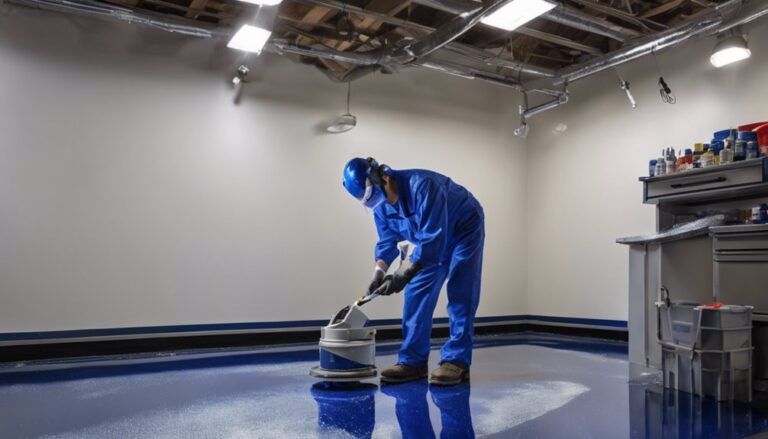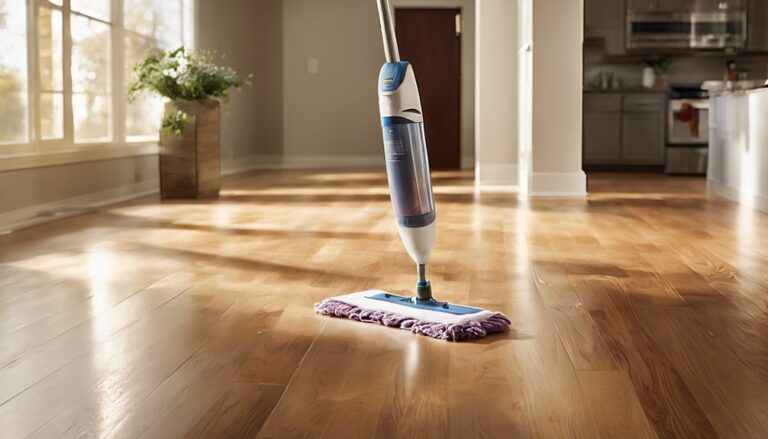To get rid of wax on your floor, first identify the type of wax and your floor material to choose the right removal method. Clear and clean the area thoroughly. You can soften the wax with a hairdryer on low heat, then gently scrape it away. For stubborn residue, try isopropyl alcohol or a natural remedy like vinegar. Use caution to avoid damage. If you want to learn more, you’ll find detailed tips and preventative advice ahead.
Identifying the Type of Wax on Your Floor

Before you can effectively remove wax from your floor, you need to identify the type of wax you’re dealing with. Different wax types respond uniquely depending on the floor materials beneath them. For example, paraffin wax, common in candles, hardens quickly and may crack on hardwood, while beeswax tends to be softer and more pliable, often found on natural wood floors. Carnauba wax, a popular floor finish, creates a glossy, durable layer but requires specific solvents for removal. Knowing whether your floor is hardwood, tile, laminate, or vinyl helps you choose the right removal method without damaging the surface. Take note of the wax’s texture, color, and source to match it with your floor materials. This clarity lets you take control and efficiently restore your floor’s freedom from unwanted wax.
Preparing Your Floor for Wax Removal
To prepare your floor for wax removal, start by clearing the area completely to avoid any obstacles while you work. Proper floor preparation guarantees a smooth, effective process and protects your vloeren. Gather all necessary cleaning supplies before you begin to save time and maintain focus. Follow these steps:
Clear the area and gather supplies first to ensure a smooth, efficient wax removal process.
- Sweep or vacuum the floor to remove dust and loose debris.
- Use a mild detergent with warm water to clean the surface thoroughly.
- Dry the floor completely with a clean cloth or towel.
- Protect nearby furniture and walls with plastic sheeting or old towels.
These steps create a clean, unobstructed workspace, making wax removal safer and more efficient while preserving your freedom to move and work unhindered.
Using Heat to Soften and Remove Wax

You’ll want to apply heat carefully to avoid damaging your floor. Use a hairdryer or warm cloth to gently soften the wax, making it easier to remove. Always keep the heat moving and avoid direct contact to prevent burns or discoloration.
Applying Heat Safely
Although applying heat is an effective way to soften wax for easier removal, you need to handle it carefully to avoid damaging your floor. Different heat sources can vary in intensity, so taking the right heat precautions is critical.
Follow these steps to apply heat safely:
- Choose a controlled heat source, like a hairdryer or heat gun, set to low or medium.
- Keep the heat source moving constantly to prevent scorching or warping the floor.
- Test the heat on a small, inconspicuous area first to verify it won’t damage the finish.
- Use a protective barrier, such as a cloth or parchment paper, between the heat source and wax to evenly distribute heat and avoid direct contact.
Softening Wax Techniques
Once the heat is applied safely, the wax will start to soften, making it much easier for you to remove without scratching or damaging the floor. Use softening methods like a hairdryer or warm towels to gently loosen the wax’s grip. Hold the heat source a few inches away, moving it continuously to avoid overheating any spot. Once softened, scrape the wax off carefully with a plastic scraper or credit card to protect your flooring. If you prefer wax alternatives, consider products that dissolve wax residues without harsh chemicals. Always test any method on a small, hidden area first. This approach gives you control and freedom, ensuring your floor stays pristine while you efficiently eliminate unwanted wax buildup.
Chemical Solutions for Stubborn Wax Residue
When heat doesn’t fully remove wax, chemical solvents like rubbing alcohol or mineral spirits can help break down stubborn residue. You’ll need to apply them carefully, ensuring proper ventilation and testing on a small area first to avoid damage. After treatment, wipe the floor thoroughly to eliminate any leftover chemicals and restore a clean surface.
Solvent Options Explained
If you’ve tried scraping and heating without success, chemical solvents can effectively break down stubborn wax residue on your floor. Understanding solvent types and application methods will help you choose the right approach for your situation.
- Isopropyl Alcohol – Ideal for gentle removal; apply with a cloth to dissolve wax without damaging surfaces.
- Mineral Spirits – Suitable for tougher wax; use sparingly with a soft cloth to avoid harming finishes.
- Acetone – Powerful solvent for heavy buildup; apply cautiously and test on a hidden spot first.
- Commercial Wax Removers – Formulated specifically for wax removal; follow manufacturer’s instructions for best results.
Select the solvent based on your floor type and wax severity. Apply carefully, ensuring even coverage to loosen residue efficiently.
Application Safety Tips
Although chemical solvents are effective at removing stubborn wax, you’ll need to handle them with care to protect yourself and your floor. Always wear appropriate safety gear, including gloves and eye protection, to avoid skin irritation and accidental splashes. Verify your workspace preparation is thorough: ventilate the area well by opening windows or using fans to disperse fumes. Clear the floor of furniture and cover nearby surfaces to prevent accidental damage. Test the solvent on a small, hidden patch first to check for discoloration or damage. Avoid mixing chemicals, which can produce harmful reactions. Keep a fire extinguisher nearby if using flammable solvents. By following these safety tips, you’ll maintain control and safeguard your freedom while effectively tackling tough wax residue.
Removing Residue Effectively
Because wax can bond tightly to floor surfaces, chemical solutions are often your best option for thorough removal. To free your floors from stubborn wax residue, consider these effective wax removal techniques within your floor cleaning methods:
- Apply a commercial wax remover designed specifically for your floor type, following label instructions precisely.
- Use isopropyl alcohol or mineral spirits on a soft cloth to dissolve residue gently without damage.
- Test any chemical solution on a small, inconspicuous area first to verify it won’t harm your flooring.
- After treatment, clean the floor with a mild detergent and warm water to remove any chemical traces.
Natural Remedies to Remove Wax Safely
When dealing with wax on your floor, natural remedies offer a safe and effective alternative to harsh chemicals. Start by freezing the wax with an ice pack; this makes it brittle and easier to scrape off gently without damaging your floor. Then, use a cloth dampened with vinegar or lemon juice—both natural cleaners known for breaking down wax residue. For stubborn spots, apply a mixture of baking soda and water to form a paste; scrub lightly to lift the wax without scratching. These eco friendly options not only protect your floors but also keep your indoor air free from toxins. Remember, patience and gentle methods give you the freedom to maintain your floors safely, avoiding harsh chemicals that can harm both your home and the environment.
Preventing Future Wax Buildup on Floors

To keep wax from building up on your floors, you’ll want to establish regular cleaning habits and use protective measures. Implementing effective wax prevention strategies alongside consistent floor maintenance tips will help preserve your floor’s appearance and freedom from sticky residue.
- Clean spills immediately to prevent wax from hardening.
- Use floor mats in high-traffic or wax-prone areas.
- Avoid dragging wax-related objects across floors.
- Schedule routine deep cleaning sessions to remove any wax traces early.




